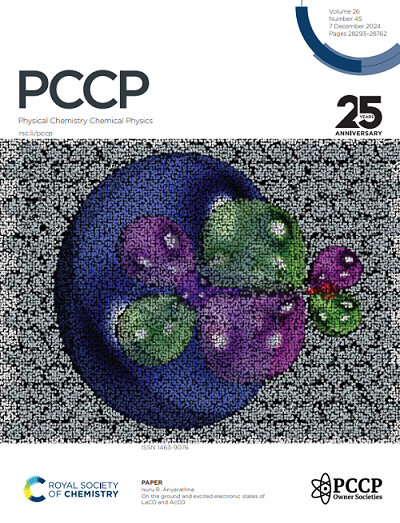大气压等离子体射流的磁场增强放电和水活化:辅助区域的影响和潜在的物理化学机制
IF 2.9
3区 化学
Q3 CHEMISTRY, PHYSICAL
引用次数: 0
摘要
磁场辅助有望成为提高常压等离子体射流(APPJ)效率的一种新方法或补充方法,但目前对磁场和等离子体之间的辅助区域对APPJ应用的影响还缺乏研究。在此,我们以 130 mT 垂直磁场辅助 APPJ 处理去离子水制备等离子活化水(PAW)为模型,研究了磁场辅助区域对 APPJ 制备的 PAW 性能的影响,发现引入磁场始终能提高制备的 PAW 的性能,在 H2O2、但这种增强效果与磁场辅助区有关,而不是 APPJ 区,在 APPJ 区,当磁场不作用于喷射管壁时(仅辅助等离子体羽流),PAW 性能达到最佳。为了揭示不同磁场辅助区域下 PAW 性能增强差异背后的物理化学机制,研究人员考虑了涉及物理参数和化学产物的等离子体反应网络。结果表明,磁场辅助区域调节了禁锢效应和磁化电子重组损耗之间的平衡,并在不显著改变放电强度、放电功率、等离子体羽流和气体温度Tgas的情况下,通过电子密度ne和电子激发温度Texc介导的等离子体反应网络改变了PAW中的活性物种。这些见解有助于理解磁场辅助区域效应对 APPJ 的影响机制,从而为优化放电活动和促进应用开发提供指导。本文章由计算机程序翻译,如有差异,请以英文原文为准。
Magnetic field enhanced discharge and water activation of atmospheric pressure plasma jet: effect of assistance region and underlying physico-chemical mechanism
Magnetic field-assistance holds the promise of becoming a new or complementary approach to enhance the efficiency of atmospheric pressure plasma jet (APPJ), but there is currently a lack of research on the effect of the assistance region between magnetic field and plasma on application of APPJ. Herein, using a 130 mT perpendicular magnetic field to assist APPJ in treating deionized water to prepare plasma activated water (PAW) as a model, we studied the effect of magnetic field-assisted region on the performance of PAW produced by APPJ, and found that introducing a magnetic field could always enhance the performance of the prepared PAW with higher concentrations of H2O2, NO3-, and NO2- and lower concentrations of O3 and lower pH values, but this enhancement effect was related to the magnetic field-assisted region relative to the APPJ, where the optimized PAW performance was achieved when the magnetic field did not act on the jet tube wall (only assisting plasma plume). To reveal the underlying physico-chemical mechanism behind the differences in the enhanced performance of PAW under different magnetic field-assisted regions, a plasma reaction network involving physical parameters and chemical products was considered. The results showed that the magnetic field-assisted region modulated the equilibrium between the confinement effect and the recombination loss of magnetized electrons, and subsequently altered the reactive species in PAW via plasma reaction network mediated by electron density ne and electron excitation temperature Texc which without remarkable changing the discharge intensity, discharge power, plasma plume, and gas temperature Tgas. These insights contribute to understanding the mechanism of magnetic field-assisted region effect on APPJ which provide guidance for optimizing discharge activity and promote the development of applications.
求助全文
通过发布文献求助,成功后即可免费获取论文全文。
去求助
来源期刊

Physical Chemistry Chemical Physics
化学-物理:原子、分子和化学物理
CiteScore
5.50
自引率
9.10%
发文量
2675
审稿时长
2.0 months
期刊介绍:
Physical Chemistry Chemical Physics (PCCP) is an international journal co-owned by 19 physical chemistry and physics societies from around the world. This journal publishes original, cutting-edge research in physical chemistry, chemical physics and biophysical chemistry. To be suitable for publication in PCCP, articles must include significant innovation and/or insight into physical chemistry; this is the most important criterion that reviewers and Editors will judge against when evaluating submissions.
The journal has a broad scope and welcomes contributions spanning experiment, theory, computation and data science. Topical coverage includes spectroscopy, dynamics, kinetics, statistical mechanics, thermodynamics, electrochemistry, catalysis, surface science, quantum mechanics, quantum computing and machine learning. Interdisciplinary research areas such as polymers and soft matter, materials, nanoscience, energy, surfaces/interfaces, and biophysical chemistry are welcomed if they demonstrate significant innovation and/or insight into physical chemistry. Joined experimental/theoretical studies are particularly appreciated when complementary and based on up-to-date approaches.
 求助内容:
求助内容: 应助结果提醒方式:
应助结果提醒方式:


